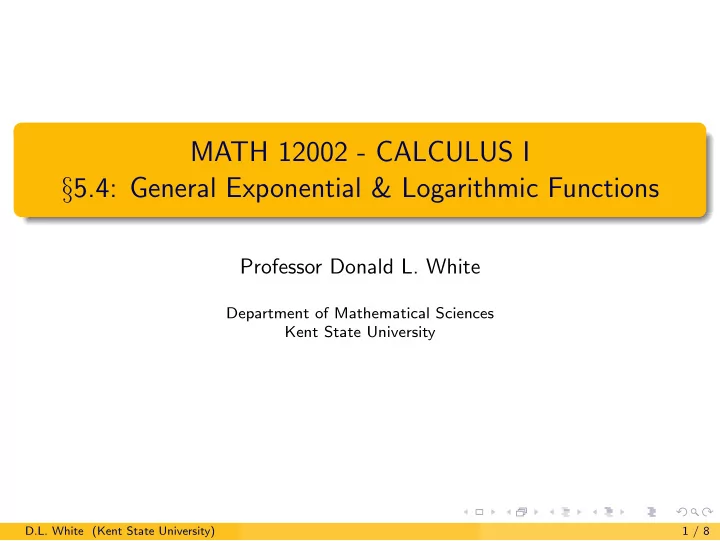

MATH 12002 - CALCULUS I § 5.4: General Exponential & Logarithmic Functions Professor Donald L. White Department of Mathematical Sciences Kent State University D.L. White (Kent State University) 1 / 8
Exponential Functions An exponential function is a function of the form f ( x ) = a x , where a > 0, a � = 1 is a constant. For example, f ( x ) = e x , f ( x ) = 2 x , and f ( x ) = ( 1 2 ) x are all exponential functions. Contrast these with power functions of the form f ( x ) = x n , where n is a constant, such as f ( x ) = x 2 , f ( x ) = x 1 / 2 , or f ( x ) = x e . D.L. White (Kent State University) 2 / 8
Exponential Functions If a > 0 and r = m / n is a rational number ( m , n integers, and n > 0) √ we know that “ a r ” means a m / n = n a m . √ The meaning of a x when x is irrational (2 2 , for example), is less clear. We could define a x using rational approximations to x : a x = a r . lim r → x r rational It is more convenient, however, to define a x in terms of e x . � x t dt and e x as the inverse of ln x . 1 We have defined ln x = 1 Hence for z > 0, e ln z = z . In particular, a x = e ln( a x ) = e x ln a , and so we have for any constant a > 0, a x = e (ln a ) x . D.L. White (Kent State University) 3 / 8
Properties and Graphs Let a be a constant, a > 0 and a � = 1, and let f ( x ) = a x . f ( x ) = a x > 0 for all real numbers x . f (0) = a 0 = 1, and so the point (0 , 1) is on the graph. f (1) = a 1 = a , and so the point (1 , a ) is on the graph. f ( − 1) = a − 1 = 1 a , and so the point ( − 1 , 1 / a ) is on the graph. The points (0 , 1), (1 , a ), and ( − 1 , 1 / a ) are useful reference points for drawing the graph of f ( x ) = a x and for comparing graphs for different values of a . Other basic properties depend on whether a > 1 or a < 1. D.L. White (Kent State University) 4 / 8
Properties and Graphs Let a be a constant, a > 1 , and let f ( x ) = a x . f ( x ) is always increasing. f ( x ) is always concave up. x → + ∞ a x = + ∞ . lim x →−∞ a x = 0, so y = 0 is a horizontal asymptote at −∞ . lim The graph of f ( x ) = a x has the following shape: § 5.4 Figure 1 D.L. White (Kent State University) 5 / 8
Properties and Graphs Let a be a constant, 0 < a < 1 , and let f ( x ) = a x . f ( x ) is always decreasing. f ( x ) is always concave up. x → + ∞ a x = 0, so y = 0 is a horizontal asymptote at + ∞ . lim x →−∞ a x = + ∞ . lim The graph of f ( x ) = a x has the following shape: § 5.4 Figure 2 D.L. White (Kent State University) 6 / 8
General Logarithms Let a > 0 and a � = 1. Since f ( x ) = a x is either always increasing or always decreasing, it is a one-to-one function, hence has an inverse. The inverse of f ( x ) = a x is the logarithm with base a , denoted log a x . Notes: f ( x ) = a x has domain ( −∞ , ∞ ) and range (0 , ∞ ). f − 1 ( x ) = log a x has domain (0 , ∞ ) and range ( −∞ , ∞ ). ⇒ a y = x . log a x = y ⇐ ln x = log e x . log 10 x is often denoted log x . The general logarithm log a x turns out to be a constant multiple of ln x , so for our purposes is not very important. D.L. White (Kent State University) 7 / 8
General Logarithms Finally, we relate log a x and the natural logarithm ln x . Set log a x = y . We then have x = a y and taking the natural logarithm of both sides, we get ln x = ln( a y ) = y ln a . Hence y = ln x / ln a ; that is 1 log a x = ln a ln x . With the formula we derived earlier, a x = e (ln a ) x , we can now convert any general exponential or logarithmic function to a natural exponential or logarithmic function. D.L. White (Kent State University) 8 / 8
Recommend
More recommend